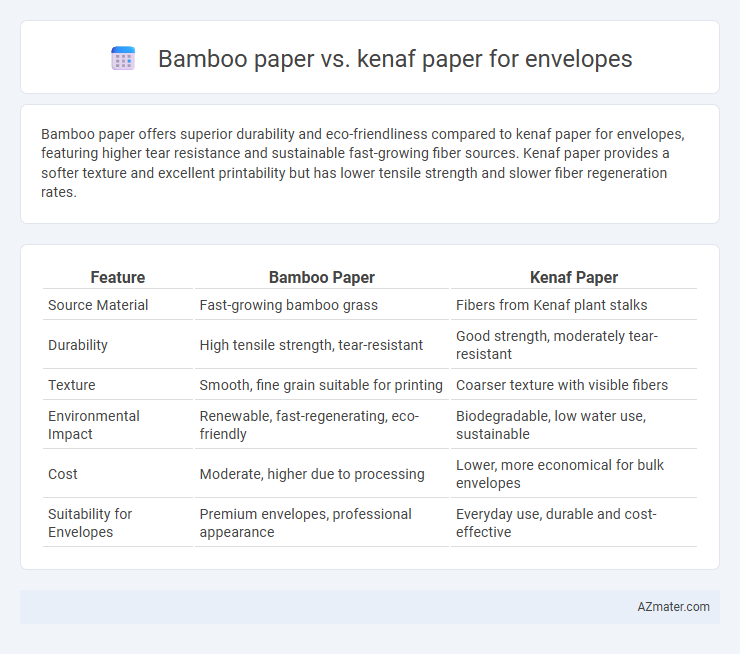Bamboo paper offers superior durability and eco-friendliness compared to kenaf paper for envelopes, featuring higher tear resistance and sustainable fast-growing fiber sources. Kenaf paper provides a softer texture and excellent printability but has lower tensile strength and slower fiber regeneration rates.
Table of Comparison
| Feature | Bamboo Paper | Kenaf Paper |
|---|---|---|
| Source Material | Fast-growing bamboo grass | Fibers from Kenaf plant stalks |
| Durability | High tensile strength, tear-resistant | Good strength, moderately tear-resistant |
| Texture | Smooth, fine grain suitable for printing | Coarser texture with visible fibers |
| Environmental Impact | Renewable, fast-regenerating, eco-friendly | Biodegradable, low water use, sustainable |
| Cost | Moderate, higher due to processing | Lower, more economical for bulk envelopes |
| Suitability for Envelopes | Premium envelopes, professional appearance | Everyday use, durable and cost-effective |
Introduction to Sustainable Paper Choices
Bamboo paper offers fast renewability due to bamboo's rapid growth cycle, making it a highly sustainable option for envelope production. Kenaf paper, derived from the Hibiscus cannabinus plant, provides strong fiber content that results in durable, eco-friendly envelopes with a lower environmental footprint compared to traditional wood pulp paper. Both materials reduce deforestation and chemical use, positioning them as leading sustainable paper choices in the packaging industry.
Overview of Bamboo Paper Production
Bamboo paper production involves harvesting mature bamboo, which is stripped, cleaned, and mechanically or chemically pulped to extract fibers, creating a sustainable and eco-friendly raw material. This method emphasizes the rapid growth cycle of bamboo, allowing for frequent harvesting without deforestation, significantly lowering the environmental impact compared to traditional wood pulp. The resulting bamboo fibers produce durable, smooth-textured paper ideal for envelopes requiring strength and a natural aesthetic.
Kenaf Paper Manufacturing Process
Kenaf paper manufacturing involves harvesting the bast fibers of the kenaf plant, which are separated through a series of retting, decortication, and refining steps to produce a strong and durable pulp ideal for envelope production. The fibers are chemically or mechanically processed to remove lignin and other impurities, resulting in a smooth texture and high absorbency that enhances print quality and tear resistance. Compared to bamboo paper, kenaf paper offers a more sustainable manufacturing process with lower water and energy consumption, making it a preferred choice for eco-friendly envelope production.
Environmental Impact: Bamboo vs Kenaf Paper
Bamboo paper production requires less water and grows faster than kenaf, making it a more sustainable option with lower environmental impact. Kenaf paper, while renewable, involves higher water usage and slower growth cycles, which can increase its ecological footprint. Both papers offer biodegradability and reduced reliance on wood pulp, but bamboo's rapid renewability provides superior carbon sequestration and soil preservation benefits.
Material Strength and Durability Comparison
Bamboo paper offers superior tensile strength and resistance to tearing compared to kenaf paper, making it ideal for durable envelopes that withstand rough handling. Kenaf paper provides good durability with a fibrous texture that enhances tear resistance but generally falls short of bamboo paper's robustness under stress. Bamboo fibers are denser and longer, resulting in envelopes with enhanced structural integrity and longevity in postal environments.
Print Quality and Finish for Envelopes
Bamboo paper offers a smooth, consistent surface ideal for high-resolution printing, ensuring sharp text and vibrant colors on envelopes. Kenaf paper, while slightly coarser, provides a natural texture that enhances tactile appeal but may result in less precise print details. The finish of bamboo paper typically appears more polished and uniform, whereas kenaf paper delivers a rustic, eco-friendly aesthetic suited for brands prioritizing sustainability.
Cost Analysis: Bamboo vs Kenaf Paper
Bamboo paper generally offers a lower production cost compared to kenaf paper due to faster bamboo growth cycles and higher yield per acre, leading to more sustainable raw material sourcing. Kenaf paper, while slightly more expensive, benefits from its lightweight and strong fiber composition, which can reduce transportation costs and enhance durability in envelopes. Evaluating total expenditure reveals bamboo paper may be more cost-effective for high-volume envelope manufacturing, whereas kenaf paper can justify its higher price through performance-driven savings.
Biodegradability and Recycling Options
Bamboo paper offers superior biodegradability compared to kenaf paper due to its fast-growing fibers that break down more rapidly in composting environments. Kenaf paper, while also biodegradable, tends to have a slightly longer decomposition period because of its denser fiber structure. Both materials support eco-friendly recycling options, but bamboo's softer fibers facilitate easier pulp recovery, making bamboo paper envelopes more efficient for circular recycling processes.
Consumer Perception and Market Trends
Bamboo paper is perceived by consumers as a sustainable and eco-friendly option, often favored for its durability and smooth texture in envelope production. Kenaf paper gains market traction due to its strong fibers and biodegradability, appealing to environmentally conscious buyers seeking green packaging solutions. Market trends indicate a growing demand for both bamboo and kenaf papers, driven by increasing awareness of sustainable materials and corporate sustainability commitments.
Choosing the Best Eco-Friendly Envelope Paper
Bamboo paper offers exceptional durability and a smooth texture while being highly sustainable due to bamboo's rapid growth and minimal water requirements, making it an excellent choice for eco-friendly envelopes. Kenaf paper, derived from the kenaf plant, provides strong fiber content and a natural beige tone, which enhances biodegradability and reduces environmental impact during production. Selecting between bamboo and kenaf paper depends on priorities like fiber strength, visual appeal, and carbon footprint, with both serving as superior alternatives to traditional wood-pulp envelopes.

Infographic: Bamboo paper vs Kenaf paper for Envelope
 azmater.com
azmater.com